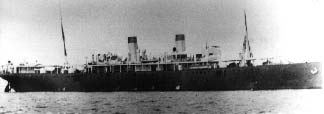|
|
|
| Missing In Action (MIA) | Prisoners Of War (POW) | Unexploded Ordnance (UXO) |
| Chronology | Locations | Aircraft | Ships | Submit Info | How You Can Help | Donate |
|
| Kaiserliche Marine Armed merchant raider 3,500 Tons 290' 8 x 10.5 cm SK L/35 guns  Kriegsmarine c1914 |
Ship History Built by Schichau Yard at Elbing, Germany for the the Russian Volunteer Fleet. Launched 1909 as Ryazan named for Ryazan, Russia. Also spelled Rjasan or Rjäsan. Used by Russia as a passenger and cargo vessel operating in the Far East and northern Pacific. World War I On August 4, 1914 captured by SMS Emden off Korea and was the first Russian war prize in World War I. Afterwards, taken to Tsingtao. Commissioned into the Kaiserliche Marine as SMS Cormoran (Cormoran II), replacing the original SMS Cormoran was laid up and unable to put to sea. The captured ship was converted into an armed merchant raider with eight 10.5 cm SK L/35 guns from old ship transfered aboard. On August 10, 1914 departs Tsingtao and steamed to the South Pacific while trying to avoid Japanese Navy warships. During late September, SMS Cormoran escaped from the Madang area prior to the arrival of the Australian Naval and Military Expeditionary Force (AN&MEF). On December 14, 1914 the Cormoran arrived at Apra Harbor off Guam with only 50 tons of coal remaining. Due to both the very unstable relationships between Germany and the U.S., and that Guam also had a very limited amount of coal, the Guam Military Governor refused to supply the Cormoran with more than a token amount of coal, hence, she was forced into internment on Guam. Over the next two years the crew became guests of the Guamanians, and relations were very good. Eventually, the crew moved off the ship and settled into a "normal" routine ashore. Sinking History On April 7, 1917 at the outbreak of the United States entry into World War I, Captain Adalbert Zuckschwerdt, ordered Cormoran to be scuttled into Apra Harbor, instead of turning her over to the Americans. Thirteen crew members went down with the ship and they were buried with full military honors in the Naval cemetery in Agana. The remainder of the crew was sent to Fort Douglas, Utah for the duration of the war. They were finally sent home to Germany on October 7, 1919. Later, on August 27, 1943 damaged Tokai Maru sank almost directly beside her. Shipwreck The hull of the Cormoran is intact. The engine room is easily accessible through the skylights, and most of the superstructure is relatively intact. Visibility averages 35-40', but can vary due to the tide and large ship traffic in the harbor. Visibility averages 35-40', but can vary due weather and tidal flows. Contribute
Information Last Updated
|
80'-120' |
| Discussion Forum | Daily Updates | Reviews | Museums | Interviews & Oral Histories |
|